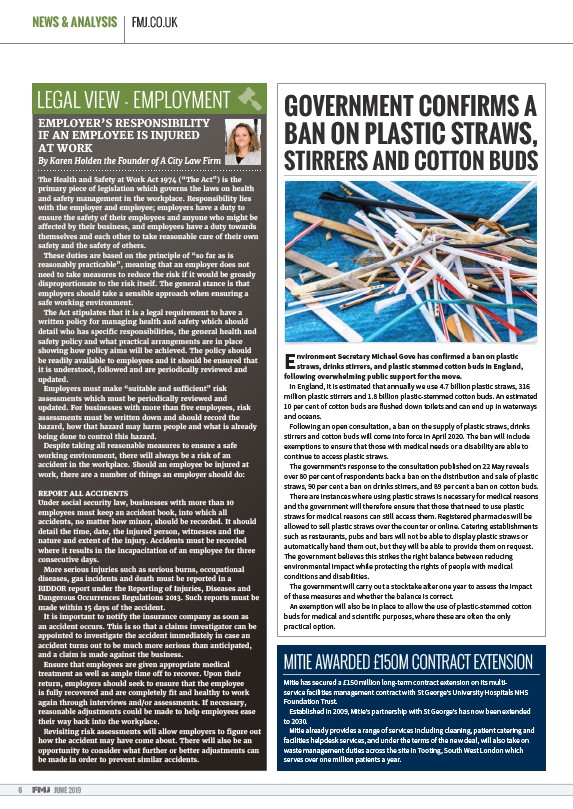
NEWS & ANALYSIS FMJ.CO.UK
LEGAL VIEW - EMPLOYMENT
6 JUNE 2019
GOVERNMENT CONFIRMS A
BAN ON PLASTIC STRAWS,
STIRRERS AND COTTON BUDS
Environment Secretary Michael Gove has confirmed a ban on plastic
straws, drinks stirrers, and plastic stemmed cotton buds in England,
following overwhelming public support for the move.
In England, it is estimated that annually we use 4.7 billion plastic straws, 316
million plastic stirrers and 1.8 billion plastic-stemmed cotton buds. An estimated
10 per cent of cotton buds are flushed down toilets and can end up in waterways
and oceans.
Following an open consultation, a ban on the supply of plastic straws, drinks
stirrers and cotton buds will come into force in April 2020. The ban will include
exemptions to ensure that those with medical needs or a disability are able to
continue to access plastic straws.
The government’s response to the consultation published on 22 May reveals
over 80 per cent of respondents back a ban on the distribution and sale of plastic
straws, 90 per cent a ban on drinks stirrers, and 89 per cent a ban on cotton buds.
There are instances where using plastic straws is necessary for medical reasons
and the government will therefore ensure that those that need to use plastic
straws for medical reasons can still access them. Registered pharmacies will be
allowed to sell plastic straws over the counter or online. Catering establishments
such as restaurants, pubs and bars will not be able to display plastic straws or
automatically hand them out, but they will be able to provide them on request.
The government believes this strikes the right balance between reducing
environmental impact while protecting the rights of people with medical
conditions and disabilities.
The government will carry out a stocktake aˆ er one year to assess the impact
of these measures and whether the balance is correct.
An exemption will also be in place to allow the use of plastic-stemmed cotton
buds for medical and scientific purposes, where these are oˆ en the only
practical option.
MITIE AWARDED £150M CONTRACT EXTENSION
Mitie has secured a £150 million long-term contract extension on its multiservice
facilities management contract with St George’s University Hospitals NHS
Foundation Trust.
Established in 2009, Mitie’s partnership with St George’s has now been extended
to 2030.
Mitie already provides a range of services including cleaning, patient catering and
facilities helpdesk services, and under the terms of the new deal, will also take on
waste management duties across the site in Tooting, South West London which
serves over one million patients a year.
EMPLOYER’S RESPONSIBILITY
IF AN EMPLOYEE IS INJURED
AT WORK
By Karen Holden the Founder of A City Law Firm
The Health and Safety at Work Act 1974 (“The Act”) is the
primary piece of legislation which governs the laws on health
and safety management in the workplace. Responsibility lies
with the employer and employee; employers have a duty to
ensure the safety of their employees and anyone who might be
aff ected by their business, and employees have a duty towards
themselves and each other to take reasonable care of their own
safety and the safety of others.
These duties are based on the principle of “so far as is
reasonably practicable”, meaning that an employer does not
need to take measures to reduce the risk if it would be grossly
disproportionate to the risk itself. The general stance is that
employers should take a sensible approach when ensuring a
safe working environment.
The Act stipulates that it is a legal requirement to have a
written policy for managing health and safety which should
detail who has specifi c responsibilities, the general health and
safety policy and what practical arrangements are in place
showing how policy aims will be achieved. The policy should
be readily available to employees and it should be ensured that
it is understood, followed and are periodically reviewed and
updated.
Employers must make “suitable and suffi cient” risk
assessments which must be periodically reviewed and
updated. For businesses with more than fi ve employees, risk
assessments must be written down and should record the
hazard, how that hazard may harm people and what is already
being done to control this hazard.
Despite taking all reasonable measures to ensure a safe
working environment, there will always be a risk of an
accident in the workplace. Should an employee be injured at
work, there are a number of things an employer should do:
REPORT ALL ACCIDENTS
Under social security law, businesses with more than 10
employees must keep an accident book, into which all
accidents, no matter how minor, should be recorded. It should
detail the time, date, the injured person, witnesses and the
nature and extent of the injury. Accidents must be recorded
where it results in the incapacitation of an employee for three
consecutive days.
More serious injuries such as serious burns, occupational
diseases, gas incidents and death must be reported in a
RIDDOR report under the Reporting of Injuries, Diseases and
Dangerous Occurrences Regulations 2013. Such reports must be
made within 15 days of the accident.
It is important to notify the insurance company as soon as
an accident occurs. This is so that a claims investigator can be
appointed to investigate the accident immediately in case an
accident turns out to be much more serious than anticipated,
and a claim is made against the business.
Ensure that employees are given appropriate medical
treatment as well as ample time off to recover. Upon their
return, employers should seek to ensure that the employee
is fully recovered and are completely fi t and healthy to work
again through interviews and/or assessments. If necessary,
reasonable adjustments could be made to help employees ease
their way back into the workplace.
Revisiting risk assessments will allow employers to fi gure out
how the accident may have come about. There will also be an
opportunity to consider what further or better adjustments can
be made in order to prevent similar accidents.